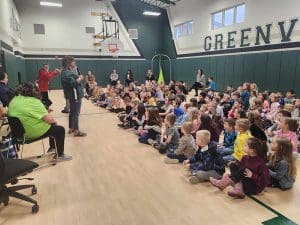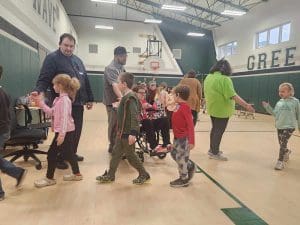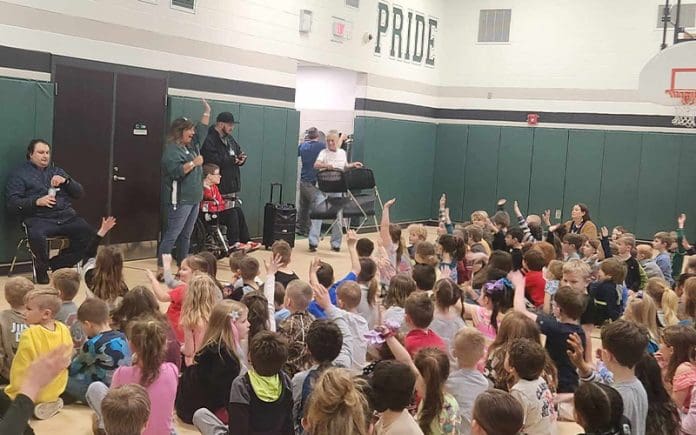DARKE COUNTY – The month of March is Developmental Disabilities Awareness Month. To help bring awareness, members of the Darke County Board of Developmental Disabilities are giving presentations to elementary schools across Darke County, meeting with kids from Kindergarten to Fourth grade.
They started with Mississinaway Valley on February 23. Then, on March 5, they visited Ansonia. On March 6, they visited Greenville. March 14, they are visiting Arcanum. On March 18, they will visit Tri-Village. On March 19, they will visit Versailles. March 21, they will visit Franklin Monroe. Finally, they will visit Bradford on March 22.
At Greenville schools, the students were brought into one of the gyms to hear the presentation.
At the beginning of the presentation, Sue Huston, Community Connections & Advocacy Coordinator at Darke County Developmental Disabilities, asked the students if they could define disability.
“You said when somebody has to do something a little bit different than other people, that’s a perfect definition!” Sue said.

Each member who presented shared a bit about themselves and their disabilities.
One member of Darke DD, Sam, talked about his life with Autism. He spoke of his favorite movies, his hobbies, and where he works. He also shared a lot of fun facts. For example, he works at McDonald’s and shared how the slogan evolved into, “I’m lovin it.”
He also shared that when he was in school, he was one of the first people to take courses that weren’t part of his Individual evaluation plan. He shared how he was treated differently from other kids he went to school with. All members shared that they have a story where they weren’t always treated the same as their peers, not being allowed to do the same thing as them.
“Nowadays, it’s normal for someone with a disability like Katie or me to be in extra classes, like Interactive media courses or classes that were normally not required by a service plan,” Sam said. But back in 2008 or 2009, that was unheard of. I was one of the first students on an individual evaluation plan to take non-IEP-regulated classes. That was Interactive Media.”
Once Sam got into Interactive Media, he was at the top of his class.
Another member, Katie, talked about her life with Autism and Schizophrenia. Katie shared that while Sam’s autism helps him become very book-smart, her Autism helps her be more creative.
She also shared how her Schizophrenia affects the way she sees the world.
“If I stand up here, you can see me, right?” Katie said. “Well, if I sit here and I look at one of your teachers, all I see is a circle for a head, two sticks for arms, two sticks for legs, and a square body or a triangle body, depending on their gender. So everyone is flat; it looks kind of like a bathroom sign.”
Tony talked about his life with Cerebral Palsy, including how he needs to walk a little daily to stretch and work his muscles. To explain this to the elementary students, they had them flex their arm muscles really tight and asked how it felt, showing how it’s important to keep muscles flexible.
While talking with Tony, they discussed how the same disability could look different on different people. They brought up a member named Paula, whom the students had met before. Paula also has Cerebral Palsy but can’t walk like Tony can, and her chair is remote-controlled.
The members then talked about how everyone is different from one another, whether they have developmental disabilities or not. People look different, have different likes and dislikes, have different beliefs, and have different abilities. No two people are exactly the same.
“I have a question for you all,” Sam said. “If we all looked the same and were genetic clones of each other, how would you guys feel? Wouldn’t it be more boring?”
The students and members of Darke DD agreed that being different from one another is a good thing and can be fun. Members of Darke DD shared that while we are all different, that doesn’t mean we don’t all want the same things. They gave examples of how we all want friends, to have fun, and somebody to play with.
Darke DD went on to discuss how, in order to be more inclusive, we should focus on what we have in common rather than our differences. They talked to the students about what they might have in common.
The students played a game with Katie to give an example of focusing on what people have in common. After asking if anyone likes to sing and seeing several hands fly in the air, Katie shared her game. The students named a song they liked, and if Katie knew it, she would sing it with all of them.
Sue had also brought books for classes to keep and read. One book was called “Just Ask,” and the other was called “Included.” The books show ways to ask each other about our differences and disabilities and how to be inclusive.
Sam shared the fun, saying, “Don’t be shy; just say hi.” It serves as a reminder not to ignore others and to treat everyone with kindness.
“We all have gifts and abilities and talents, right?” Sue said. “You guys all have things that you’re really, really good at, right? But we all need help sometimes, too, right?”
Sue asked the students if it was okay to ask for help, and the students said yes! She then asked if we should make fun of someone who asks for help, and the students said no! While we may be great at things, we all need help with some things as well.

The students were excited to be there, learn, and have fun with Sam, Katie, and Tony.
“Kindness and inclusion go farther than anything,” Sam said. So please be kind to your neighbor, be kind to yourself, and be kind to your teachers. We all need help sometimes. We’re kind of the same, and we’re kind of different, too. And it’s important to acknowledge those differences and how unique and special they are. We are all special, am I right?”








